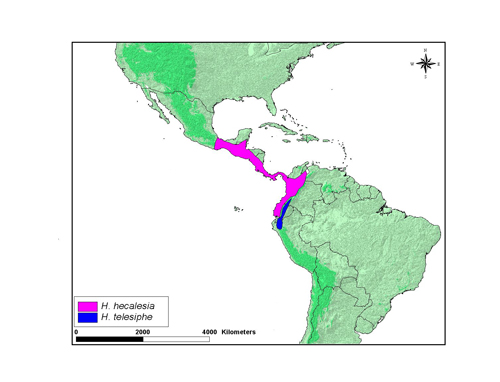Heliconius telesiphe
Margarita Beltrán and Andrew V. Z. BrowerIntroduction
Heliconius telesiphe occurs in mid-elevations in the Andes, where it is involved in a mimicry complex with another heliconiine species, Podotricha telesiphe.
Characteristics
Early stages: Eggs are yellow and approximately 1.6 x 0.8 mm (h x w). Females usually place eggs singly on growing shoots of the host plant (Brown, 1981).
Geographical Distribution
Heliconius telesiphe is distributed in the central Andes. The map below shows an approximate representation of the geographic distribution of this species. The original data used to draw these maps are derived from Brown (1979) which is available at Keith S. Brown Jr. (1979). Ecological Geography and Evolution in Neotropical Forests
Habits
H. telesiphe occurs from 600 to 2,500 m in cloud forest. Usually individuals fly rapidly and in the lowerstory. The males sit on female pupae a day before emergence, and mating occurs the next morning, before the female has completely eclosed. Adults roost at night in small groups 2-10 m above ground in twigs or tendrils (Brown, 1981).
Host plant: H. telesiphe larvae feed primarily on plants from the genus Passiflora, subgenus Plectostemma (Brown, 1981).
References
Brown K. S. 1981 The Biology of Heliconius and Related Genera. Annual Review of Entomology 26, 427-456.
Doubleday E. 1847 The genera of diurnal Lepidoptera: comprising their generic characters, a notice of their habits and transformations, and a catalogue of the species of each genus. London, Longman, Brown, Green & Longmans. 1: 87-98, pls. 16-17 (9 July 1847), 99-106, pls. 18-19 (4 August 1847), 107-110, pls. 18*, 20 (1 September 1847), 111-118, pls. 21, 23 (4 October 1847), 119-124, pls. 22, 24 (2 November 1847), 125-132, pls. 25, 28 (2 December 1847), 133-136 (7 January 1848), 137-138 (3 February 1848)
Title Illustrations

| Scientific Name | Heliconius telesiphe telesiphe |
|---|---|
| Specimen Condition | Dead Specimen |
| View | Dorsal |
| Collection | Gerardo Lamas |
| Image Use |
 This media file is licensed under the Creative Commons Attribution-NonCommercial-ShareAlike License - Version 3.0. This media file is licensed under the Creative Commons Attribution-NonCommercial-ShareAlike License - Version 3.0.
|
| Copyright |
©
Mathieu Joron

|
| Scientific Name | Heliconius telesiphe telesiphe |
|---|---|
| Specimen Condition | Dead Specimen |
| View | Ventral |
| Collection | Gerardo Lamas |
| Image Use |
 This media file is licensed under the Creative Commons Attribution-NonCommercial-ShareAlike License - Version 3.0. This media file is licensed under the Creative Commons Attribution-NonCommercial-ShareAlike License - Version 3.0.
|
| Copyright |
©
Mathieu Joron

|
About This Page
Margarita Beltrán

University of Cambridge, Cambridge, UK
Andrew V. Z. Brower

Middle Tennessee State University, Murfreesboro, Tennessee, USA
Correspondence regarding this page should be directed to Margarita Beltrán at
beltran.margarita@gmail.com
and Andrew V. Z. Brower at
abrower@mtsu.edu
Page copyright © 2010 Margarita Beltrán and Andrew V. Z. Brower
 Page: Tree of Life
Heliconius telesiphe .
Authored by
Margarita Beltrán and Andrew V. Z. Brower.
The TEXT of this page is licensed under the
Creative Commons Attribution-NonCommercial-ShareAlike License - Version 3.0. Note that images and other media
featured on this page are each governed by their own license, and they may or may not be available
for reuse. Click on an image or a media link to access the media data window, which provides the
relevant licensing information. For the general terms and conditions of ToL material reuse and
redistribution, please see the Tree of Life Copyright
Policies.
Page: Tree of Life
Heliconius telesiphe .
Authored by
Margarita Beltrán and Andrew V. Z. Brower.
The TEXT of this page is licensed under the
Creative Commons Attribution-NonCommercial-ShareAlike License - Version 3.0. Note that images and other media
featured on this page are each governed by their own license, and they may or may not be available
for reuse. Click on an image or a media link to access the media data window, which provides the
relevant licensing information. For the general terms and conditions of ToL material reuse and
redistribution, please see the Tree of Life Copyright
Policies.
- First online 18 February 2007
- Content changed 12 August 2008
Citing this page:
Beltrán, Margarita and Andrew V. Z. Brower. 2008. Heliconius telesiphe . Version 12 August 2008 (under construction). http://tolweb.org/Heliconius_telesiphe/72929/2008.08.12 in The Tree of Life Web Project, http://tolweb.org/







 Go to quick links
Go to quick search
Go to navigation for this section of the ToL site
Go to detailed links for the ToL site
Go to quick links
Go to quick search
Go to navigation for this section of the ToL site
Go to detailed links for the ToL site